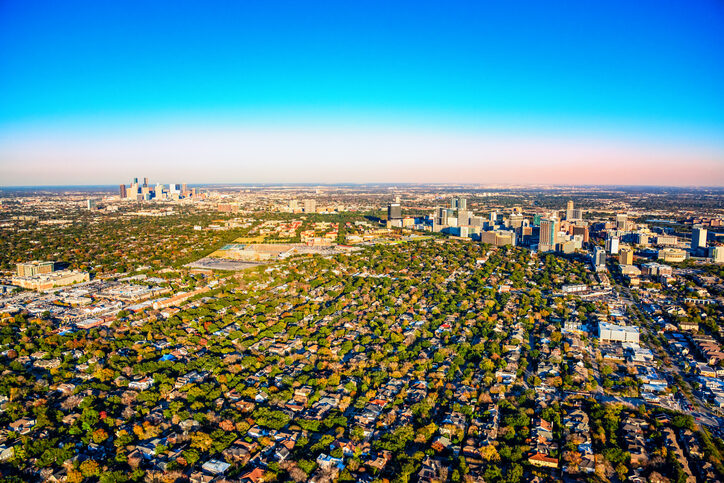CRE ‘Burbs’ are Alive and Well
Michael Beckerman

So much of the hubbub in commercial real estate right now centers on “smart cities”—we’ve tracked the trend as much as anyone—but the truth likely lies closer to home. The fact is, suburbs across the country are positively humming with CRE activity, and they always have been. Wealth and activity have always flocked to the suburbs, so it’s a natural progression to look at “smart suburbs” as fertile ground for real progress and innovation in CRE.
On a recent panel at ICSC’s RECon, our own Ash Zandieh moderated alongside speakers from both Ollie and Envoy to discuss how there is no future CRE equation without factoring in the suburbs. Cities of the future, shopping of the future, and transportation of the future are all intertwined, and suburbs are benefiting from the shift.
The 2017 American Housing Survey, 76,000 households nationwide, showed that “about 52 percent of people in the United States describe their neighborhood as suburban, while about 27 percent describe their neighborhood as urban, and 21 percent as rural,” according to CityLab. Even as trends show influxes moving into our busiest urban hubs, rising housing costs in the nation’s most popular cities are showing slowed growth. This has hastened a millennial exodus to suburban communities with populations over 50,000—think places like Frisco, Texas or Scottdale, Georgia—which now account for 14 of the 15 fastest-growing cities in the U.S. This rapid shift, however, has come at a cost.
According to Valerie Bauerlein at The Wall Street Journal, “In an echo of the postwar baby boom, many U.S. suburbs are again suffering growing pains: not enough schools, too much traffic for two-lane roads, and scenic farmland plowed under for housing tracts.”
As millennials continue to recover from the 2008 recession, which left many rooted in place—literally and figuratively—as they strained under the weight of job loss or stagnated growth at work, hefty costs of living in urban centers, and the ever-present student loan debt. As Bauerlein notes, “Many are belatedly getting married and heading to the suburbs, just as their parents and grandparents did.”
Suburbs, however, do not equate to simply subdivisions and single-family homes, as was once the primary association. Economists Barbara Byrne Denham and Victor Calanog noted that “Few recognize that the bulk of the apartment inventory is located in suburban submarkets, either within the city limits or outside. A quick look at the numbers shows that the ratio of suburban to CBD apartment stock is nearly 6:1.” This interplay is an important aspect of the urban/suburban divide in commercial real estate. Mixed use is showing its colors in the urban core, but the ‘burbs won’t be left behind—even if those ‘burbs begin to look different than those of past generations.
To understand this shift, look no further than Bell Works (formerly the historic Bell Labs building). Coined as a “metroburb,” this campus functions as a microcosm of innovation, possibility, and inspiration. Offering all the elements of a great downtown (office space, retail, art, culture, dining, and more), it’s a “self-contained metropolis in a livable and accessible suburban location.” As more amenities are jammed into next generation developments and ecommerce growth soars, the more possible it is for the suburbs to feel more like an urban core.
It’s key to note that most of those observing suburban trends focus on the millennial pursuit of “suburban areas relatively close to the city, where they can still access the hottest sushi spots in town,” while caveating that this age cohort is still in a transition phase. It remains to be seen if true suburbia—those enclaves filled with strip malls, houses of worship, chain restaurants, and subdivisions—will ever resonate with millennials like they did for Baby Boomers.
Writing for Inman, Patrick Kearns notes that of the 54 percent of respondents living in the suburbs, “33 percent live in cities and 13 percent live in exurbs”—when choosing what’s most important in their dream neighborhood, “the study found that most people want a grocery store, followed by public parks and a strong public school system. Shopping malls, theaters and houses of worship were the three least important attributes, according to respondents.”
You can’t argue that suburbs hold a major percentage of the workforce—and wealth. According to Pew Research Center, roughly “46 million Americans live in the nation’s rural counties, 175 million in its suburbs and small metros, and about 98 million in its urban core counties.” These are not figures to take lightly, especially as innovations augment how we live and commute. As self-driving becomes reality, urban flight to the ‘burbs stands to increase not decrease. As such, those investing in suburban CRE now will stand to gain as that trend plays out.
Don’t forget about the suburbs. They aren’t dead yet, and in fact, they may see a revival as we’ve never seen before when self-driving technology is actualized in the form of cars and shuttles. And if last mile flying becomes the thing Uber hopes it will, the revival may well be nigh unstoppable.
